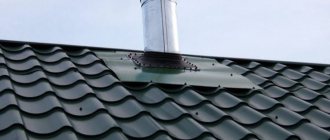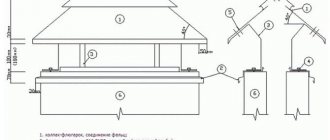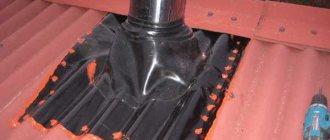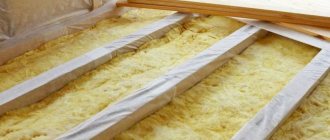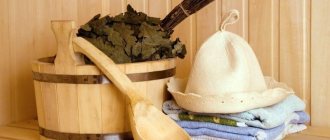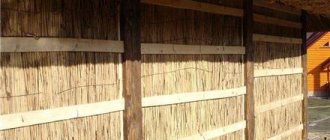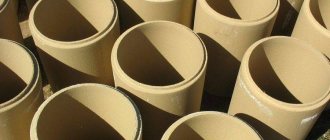Do-it-yourself chimney insulation
Before insulation, the chimney is cleaned from the inside and outside.
It is recommended to take measures to insulate the chimney in the warm season, during dry and windless weather. Such conditions are necessary to minimize the likelihood of injury.
For work you will need the following tools, devices and materials:
- hammer drill, screwdriver;
- level, tape measure;
- hammer, hacksaw, riveter;
- trowel, spatula, paint brush;
- safety equipment, assembly helmet, safety glasses and gloves, gauze bandage or respirator;
- chimney sweeper's brush
The list may be larger or smaller, depending on the chimney material and the chosen technology.
It is recommended to treat the metal with anti-corrosion agents
The insulation process consists of the following stages:
- Design. A detailed diagram is drawn up indicating all distances, parts, fastening methods and connections. Based on the drawing, a calculation of building materials is made, and a step-by-step work plan is also outlined.
- Preparatory phase. The workplace is equipped, the availability and serviceability of equipment is checked, and the condition of the safety equipment is checked.
- Cleaning the chimney from dirt and soot. First you need to clean the channel from soot. After insulation, the temperature in the pipe will increase, which can lead to ignition and fire. Then the outer surface should be cleaned of unstable fragments, dirt and vegetation.
- Pipe processing. Metal is coated with an anti-corrosion agent, asbestos cement and brick are coated with a deep penetration primer, which strengthens the material and protects it from swelling with moisture.
- Installation of insulation. It can be inserted into the frame, glued, screwed, or simply wrapped and then secured with ties or wire.
- Installation of the outer casing. The choice depends on the shape and material of the pipe. After fastening, the ends and joints are sealed.
- Finishing and removal of remaining construction waste.
Do-it-yourself insulation installation
Before starting work, you need to learn the basic rules for applying insulation, and learn how to insulate an iron chimney pipe yourself. Insulation carried out according to the rules will allow the owner not to violate the construction technology and not worry about reducing the draft in the chimney.
Required tools and materials
For installation work on insulating a chimney pipe from the outside, you will need a set of tools that are available in every household: a tape measure, a screwdriver, a grinder, self-tapping screws, metal scissors, a knife for cutting insulation, and protective equipment.
Calculation of the dimensions of the structure
To properly organize the work, you need to calculate the construction parameters and costs. The heating temperature of the inside of the outlet channel, as well as the insulating layer, depend on what type of fuel is used.
The amount of insulation is calculated according to the measurements taken:
- external parameters of the insulated surface;
- height of the structure;
- distance from the lower outlet of the pipe.
For example: on a cold roof and above it, the outlet from a solid fuel heater is wrapped with a layer of 5 cm to 10 cm. The distance on the chimney from the ceiling to the roof in an insulated attic is insulated with a layer of up to 6 cm. The exhaust structure from a gas boiler is insulated with a layer of 3 cm.
The insulation consumption for a chimney for a solid fuel boiler will be, for example, as follows: with its height of 5 m, diameter 219 cm, basalt cylinders need 5 linear meters with a layer thickness of 5 cm, parameters for the internal diameter. Sheet insulation will require 3.5 m². For the protective casing, buy galvanized steel, 2.7 cm thick.
The height of the protruding end depends on the distance of the channel to the roof ridge. Located at a distance of 1.5 m from the center of the house, the chimney should be 50 cm higher than the ridge. Two meters from the center - the height at the level of the ridge, three meters on pitched roofs - the height is determined at an angle of 10°, between the line of the horizon and the ridge.
Work progress
Before installation, you will need to buy chimney sections, anti-corrosion agent, insulation, brackets and clamps, heat-resistant sealant, moisture-proof fabric, galvanized cladding, profiles for the frame, asbestos sealant, fire-resistant foam.
- Before using the insulation, an anti-corrosion substance is applied to the pipe. A protective film is formed on the surface, which protects the metal from destruction for a long time. Combine and secure the parts of the pipe so that moisture does not enter the joints when draining. The connection should be 5-7 cm long for stability.
- After connecting the segments, the metal pipe is wrapped with insulation. The edges of the insulation are wrapped overlapping and secured with steel clamps or aluminum wire. Externally insulated wire cannot be used. Under the influence of high temperatures, the insulation will melt, the fastening strength will weaken, which will lead to deformation of the winding.
- The soft surface is covered with a vapor barrier fabric, and sheets of galvanized steel are fixed on top of it. The galvanizing is fixed with an overlap, from bottom to top, with an overlap of 7-10 cm, fixed with clamps every 30 cm.
- A hole is cut in the roof, which corresponds in diameter to the insulated chimney.
- Under the roof and on the outside of the ceiling to the rafter structure, a horizontal fastening is installed to stabilize the chimney.
- The gaps between the roof and the structure are sealed with heat-resistant non-combustible materials, blown in with heat-resistant foam, and covered with a metal casing.
The main enemy is condensation
Most of the readers have seen wet spots on brick chimneys or hanging icicles on metal pipes at least once in their lives. The reason for this phenomenon is simple - condensation in the chimney. Not everyone knows that when natural gas burns, a certain amount of water vapor is released. If the air temperature in the chimney is quite low, it falls into condensation and settles on the walls of the chimney.
The main danger of condensate is that it contains acidic compounds. They are formed from substances contained in combustion products. Acids are aggressive. They can even destroy metal pipes. If the problem of moisture in the chimney is not solved in time, it will cause destruction of the system, regardless of what material it is made from. Under the influence of acid condensate, metal pipes are destroyed within a couple of years. Liquid for chimneys made of asbestos pipes or bricks is no less dangerous. The fact is that moisture easily penetrates microcracks. When the temperature drops, it freezes, thereby compromising the integrity of the material. Thermal insulation of gas boiler chimneys allows you to extend their service life.
Condensation not only significantly reduces the service life of the chimney, but also impairs the performance of the system. Moisture reduces traction. In addition, reverse draft may occur. This phenomenon is quite dangerous, since combustion products, including carbon monoxide, will penetrate into the room. Inhaling carbon monoxide can be fatal if not treated promptly. Its main danger is that it has no odor.
At low temperatures outside, icicles on the chimney will form quite actively. This may cause an ice plug to appear, which will become an obstacle to the removal of combustion products. In this case, they will penetrate inside the room.
If the chimney is insulated, the chimney walls will not cool down quickly even during severe frosts. Thanks to this, combustion products will maintain their temperature. The absence of temperature differences will prevent the formation of condensation, which causes many serious problems. Whether it is worth saving on insulation is up to you to decide, but in most cases such a decision increases costs and can create a dangerous situation.
Insulation of a brick chimney
There are two ways to carry out work to protect pipes from freezing and condensation:
- plastering on a grid;
- insulation with mineral wool.
To protect the pipes with your own hands using the first method, you will need to perform the steps in the following order:
- Fixing the reinforcing mesh to the wall surface. Before this, the structure is cleaned of dust and dirt.
- Preparation of plaster mortar. To do this, mix lime, cement and slag with the addition of water. It is possible to use modern “warm” plaster, which has good thermal insulation characteristics.
- Applying the solution to the surface. The thickness of one layer is 20–30 mm. If necessary, the composition is applied in several layers. Each subsequent one is laid after the previous one has dried. The very last layer of plaster mortar is leveled and rubbed.
- After the plaster has dried, the surface is checked for cracks and irregularities. If necessary, they are removed. The work is completed by painting the pipe with lime or chalk paint to protect the plaster layer from negative environmental influences.
Applying a plaster layer This method is ineffective.
Mineral wool will more reliably protect the pipe from the cold. If you want to do everything yourself, follow this pattern:
- The surface is cleaned from dirt and deposits. Inspect for any irregularities and correct them if necessary.
- Assembling the frame on which the insulation will be mounted. The lathing consists of metal guide profiles, which are secured with dowels. The pitch between the guides is selected so that it is convenient to lay the insulation.
- Gaps and cracks should not be allowed to appear. They will lead to heat losses and the formation of cold bridges.
- Fastening the vapor barrier with an overlap of 15–20 cm. The joints are taped with construction tape.
- The pipe lining performs a decorative and protective function. When doing DIY work in a cold attic, you can use sheets of drywall.
Thermal insulation using mineral wool
The importance of insulation
Creating high-quality insulation for stoves or other round flue pipes is an important preventative process. Of course, this procedure will not 100% protect the structure from the negative effects of rain and other precipitation. However, insulation of metal flue ducts can significantly extend the service life of all systems.
This operation must be carried out in order to:
- Eliminate the possibility of condensate, which contains hazardous chemical elements, getting on the walls of pipe products. The presence of an insulating layer will ensure their complete evaporation along with the rest of the smoke.
- Reduce the likelihood of temperature changes in the system.
- Create an energy-saving effect. Installing insulation reduces energy losses. The presence of this layer reduces the fuel consumption of boilers or furnaces.
- Increasing the strength of the gas duct. Insulating steel pipes helps strengthen the design of the smoke exhaust system. The frame becomes more resistant to wind loads.
It is important to choose the right material for insulation. Only in this case can the system’s resistance to low temperatures be significantly increased. It can also be used to eliminate the negative impact on the roof in the form of corrugated sheets or slate. These preventive measures will extend the life of the chimney.
How to insulate the outside of a chimney?
In order to reliably insulate chimneys, materials are used that provide a high degree of thermal insulation. They exclude the influence of external climatic factors on the heat balance in the chimney duct. Manufacturers of building materials offer a wide range of modern thermal insulation materials, some of which are used as insulation for pipes.
Basalt thermal insulation
Thermal insulation, which is made from mineral wool or basalt, is widely used for insulating chimneys. This material is formed by fibers obtained from the melt of volcanic rock - gabbro-basalt, and therefore has high heat resistance and strength. Advantages of basalt thermal insulation:
- high thermal insulation properties (up to 95% of the heat is stored inside the channel);
- good permeability to steam with high waterproofing parameters;
- high chemical and corrosion resistance;
- resistance to the formation of mold and fungi;
- vibration resistance;
- high heat resistance (maintains properties when heated to 100 degrees);
- non-flammability;
- environmental cleanliness;
- resistance to ultraviolet radiation (sun rays).
Stainless steel casing
Recently, standard metal casings in the form of a stainless steel pipe have been used. The use of a metal shell provides high mechanical strength, reliable protection from moisture and aggressive substances.
Such a casing is installed on a chimney made of stainless steel pipe of smaller diameter. The interpipe space is filled with mineral basalt wool. The outside of the casing is covered with insulation up to 5 cm thick. The thickness of the gap between the pipes is 7-10 cm.
Wooden shields
One of the simplest insulation materials is wooden panels. This insulation is made in the form of a wooden frame from panels with dimensions corresponding to the dimensions of the chimney pipes. Slate or other roofing material similar to roof covering is fixed on top of the wooden panels.
After installing the frame around the pipe, the space between them is filled with thermal insulation - felt, mineral wool, slag, asbestos, sand. The seams of the wooden frame must be coated with a waterproofing compound.
Slag concrete, reinforced concrete slabs
The chimney insulation can be made from slag concrete or reinforced concrete slabs. Such plates are installed around the chimney with the smallest gap. The space between the slabs and the pipe, as well as the seams at the corners of the slab joints, are reinforced with steel wire or mesh. The gap is filled with a solution of gypsum, sand and clay. The joints of the slabs are reinforced with concrete mortar. Plaster is applied over the tiled insulation.
Choice of insulation
The choice of insulation to insulate a chimney must be approached carefully and seriously. You shouldn’t buy the cheapest one, because it should have good thermal insulation properties, be easy to use, not require additional reinforcement of the load-bearing structures of the roof and ceilings, be non-toxic and non-flammable.
Stone or basalt wool is an excellent thermal insulation made from basalt stones.
This insulation can withstand prolonged exposure to fairly high temperatures and does not burn, even when in contact with an open fire. When heated, it does not emit any toxic or unpleasant odors. Such insulation can be safely called an environmentally friendly material.
Glass wool is a type of mineral wool insulation made from waste from the glass industry. There are a large number of voids between its fibers, so it retains heat well.
Glass wool does not burn and does not absorb moisture, is not susceptible to rotting and rodents. It is not expensive and easy to use. Most often produced in slabs and rolls.
Teploizol or folgoizol are multifunctional types of insulation made of polyethylene foam and covered with a sheet of aluminum foil. It is produced in rolls and has a thickness from 2 to 10 mm. They can perfectly insulate the chimney of a bathhouse, since these insulation materials can withstand heating up to 150C°-170C°.
Construction “secrets”
Modern builders are often interested in how to wrap a metal chimney pipe? For this you can use mineral wool panels. Secure them with masking tape. But the area wrapped with mineral wool must be covered so that moisture and precipitation do not get on the mineral wool. Insulating a chimney with mineral wool is a method that is quite actively used.
It is important to protect mineral wool on the chimney from moisture and sun.
How to insulate a chimney pipe correctly so as not to redo the work? You must first make an accurate calculation of the thickness of the outer thermal insulation layer. The figure also depends on what the stove (or fireplace) is heated with: 1) if it is heated with solid fuel, then the thickness of the thermal insulation is 5-10 centimeters;
2) if they are heated with gas or diesel, then the thickness of the thermal insulation is 2-3 centimeters.
How to insulate a pipe from a gas boiler
Today, materials such as brick, glass wool or mineral wool are very popular for thermal insulation of smoke exhaust ducts. The answer to the question of how and with what to insulate the chimney of a gas boiler with your own hands, in each case depends on the material from which the chimney of the gas water heater is made.
Currently, chimneys of gas and solid fuel boilers are often made of steel, brick and asbestos pipes. Using these materials as an example, we will look at how to insulate a gas boiler pipe from condensation on the street, and what insulation materials are best to use in work.
Physical and technical properties
If polystyrene foam is properly insulated from environmental influences, it will last more than 50 years.
The popularity of polystyrene foam is directly influenced by technical characteristics:
- thermal conductivity
- density - measured in kg/m3 and indicated in the marking;
- geometric dimensions are reflected in the markings;
- water absorption;
- compressive strength.
The thermal conductivity of thermal insulation boards at a temperature of +10 degrees ranges from 0.036 W/m*K for polystyrene PSB-S-35 to 0.041 for lightweight products PSB-S-15. When the air warms up to 25 degrees, the indicators change slightly - by 1%.
A deviation of 2–5 mm in geometric dimensions is allowed. Tolerances do not affect the quality of insulation, since with such parameters the seams are small and can be easily removed with polyurethane foam.
Water absorption refers to the increase in the mass of foam when it is in water for 24 hours. During this period of time, the foam will absorb from 2 (PSB-35) to 4 (PSB-15)% of liquid from its mass. Thus, polystyrene boards are a moisture-proof material.
Compressive strength will be determined by the areas of application of a particular brand of foam, for example, PSB-15 cannot withstand loads, but polystyrene foam 35 can be walked on carefully
Insulation of a chimney pipe with basalt wool
The technology and mechanism for installing the casing is influenced by many factors, including the material from which the pipe is made, its diameter and others.
Basic rules for high-quality thermal insulation
Compliance with the following standards is mandatory when lining a chimney with a heat insulator:
- for a wooden covering, the layer of wool should be no less than 50mm and no more than 100mm;
- in passages through wood this layer should reach at least 5 cm;
- if mats of material are laid in several layers, then their joints must be covered with upper layers;
- for heat insulators in a cylindrical release form, when they are applied in several layers, each subsequent one must be laid with an offset of 180°;
- for boilers with liquid fuel or gas heating technology, it is advisable to use high-temperature cladding materials with a range of up to 300°;
- a protective screen is a mandatory insulation measure if materials without a foil layer were used during the work.
Insulation of a ceramic or asbestos chimney
For asbestos chimneys, the outer cladding procedure is carried out, and the layers of material are secured with special staples. To simplify and speed up the work, you can use basalt cylinders, the thickness of which should not exceed 5 cm.
Methods for insulating a steel chimney
The mechanism for carrying out the procedure is almost completely similar to the method for a ceramic chimney, and looks like this:
- 2 pipes of different diameters are used: a large one for the external surface, and a smaller one for interior decoration.
- One pipe is inserted into another.
- The resulting gap between the products is filled with the selected non-combustible insulation to insulate the chimney.
- If the material has a foil layer, it is not necessary to install a protective casing.
- The structure at the end must be additionally insulated.
The instructions themselves are quite simple, but they can be simplified by using ready-made sandwich pipes that replace the first 3 points of the manual. Such ready-made consumables for insulation have high heat resistance and help achieve high insulation characteristics.
Brick pipe insulation technology
Insulating a brick pipe is not an easy task.
To carry out the procedure, 2 methods are used:
- plastering;
- lining with mineral wool.
To plaster a pipe you need:
- a special reinforced mesh is installed on its outer surface;
- the first layer is applied directly to it in a small amount;
- after drying, make a thicker mixture and lay it on a mesh in several layers;
- To achieve an aesthetic appearance, after the substance has dried, it is rubbed, leveled, whitened or painted over.
For the second method - sheathing - use basalt wool in rolls or mats:
- the required amount of material is cut depending on the size of the insulated surface.
- the resulting layers of material are attached to the chimney using thick tape.
- A protective casing made of brick or slabs (optional) is mounted on top of the wool.
- The surface can be plastered or painted to achieve the desired external characteristics.
Basalt wool is the best option for insulating chimneys. It can be used for any premises: residential and industrial. It also has the necessary characteristics for these purposes - it is fireproof, resistant to moisture and vibration, and easily tolerates high and low temperatures.
How to insulate a gas boiler pipe with your own hands
How to insulate an asbestos pipe of a gas boiler
Scheme of insulation of an asbestos pipe of a gas boiler
1. To insulate asbestos boiler pipes, you can use mineral wool or bricks. It should be noted that insulation should only be done outdoors - that part of the chimney duct that comes out of the wall or is located above the attic floor. To insulate asbestos pipes of solid fuel boilers with bricks, you first need to make a steel casing and fill it with insulation.
The diameter of the casing must be 120 millimeters larger than the diameter of the pipe. It is recommended to make the casing from sections of 1.5 meters - this will allow the brick to be thoroughly compacted. The sections must fit together tightly, leaving no gaps. After installation, the top of the casing on the street must be covered with cement mortar.
2. Thermal insulation of asbestos pipes with mineral wool is simple. It is necessary to wrap the boiler pipe with material and tighten it with staples. Non-flammable basalt insulation materials should be used for insulation. In addition, a waterproofing material should be fixed on top to prevent the insulation from getting wet.
Insulation of a steel pipe of a gas boiler
How to insulate a steel pipe of a gas boiler
To insulate a steel pipe outdoors, you can use glass wool or basalt insulation. A metal chimney consists of several pipes of different diameters. Insulating a steel product with stone wool will improve the fire safety of the house, since the material is non-flammable and prevents overheating of the surface.
How to insulate a brick pipe of a gas boiler
You can insulate a brick chimney on the street by plastering the surface. Reinforced mesh is used here. The advantage of plastering a brick chimney is its low cost, but this method has low efficiency. Before starting work, you need to close the gas valve to protect against gas leakage, secure the mesh to the pipe of the solid fuel boiler and apply 3-5 layers of plaster.
We talked about this method in detail in the article “How to insulate a chimney pipe.”
Thermal insulation with plaster reduces heat loss by approximately 25%. To insulate a brick pipe outdoors, you can also use mineral insulation. The insulation should be laid closely so that there are no cold bridges, and then it is necessary to cover everything with a vapor barrier film so that the insulation does not absorb moisture from the atmosphere, gluing its joints with construction tape.
Does basalt wool insulate a chimney?
Based on the high insulating qualities, resistance to aggressive environments and thermal heating of basalt wool, we can safely give a positive answer.
When choosing a brand of insulating material for a chimney, pay attention to the density of basalt wool - it should be very dense and exhibit minimal shrinkage when heated and during operation. In addition to chimney insulation, mineral wool cushions are used, consisting of several layers, reinforced with a metal layer
In addition to chimney insulation, mineral wool cushions are used, consisting of several layers, reinforced with a metal layer.
The chimney can be made of metal, asbestos-cement pipe, or brick. To improve the efficiency of the heat generator and protect it from fire, install heat-insulating, heat-resistant material.
Basalt wool is used as a heat insulator for the chimney. It helps reduce heat loss through the chimney, as well as protect walls and ceilings from overheating.
Features of the chimney insulation process
Difficult, but possible. This is how you can describe insulating a chimney with your own hands - the process is quite complex.
It is important to follow the sequence of technological steps so that you do not have to redo it. Due to lack of heat conservation, equipment is destroyed
This is affected by condensation (i.e. moisture). Therefore, we insulate your favorite pipe without delay))
Condensation in the pipe destroys the chimney
Insulation of the chimney pipe:
- eliminates the appearance of condensation;
- will protect you from external influences and the vagaries of nature (rain, snow, wind, temperature changes);
- protects against heat loss.
Before insulating a chimney iron pipe, check whether the structure was installed correctly:
- height – at least 5 meters. This provides the best traction;
- to combustible roof elements - at least 25 centimeters;
- must have a spark arrester. This is a stainless steel mesh that encircles the structure from above.
Is it necessary to insulate the chimney of a gas boiler?
Photo. Metal is quickly destroyed by condensation
As gases and combustion products pass through the pipe, they are rapidly cooled due to heat transfer to the metal walls of the pipe. The draft in the chimney depends on the absence of soot and on how quickly the chimney walls heat up. Another indicator that affects the draft in the gas exhaust system is the time at which condensation appears in the pipe.
The fact is that when condensation forms in the pipe, it mixes with combustion products, forming an acidic solution. Over time, the walls of a brick or metal pipe collapse. All this determines the importance of proper thermal insulation of the pipe of a gas boiler outdoors. Next, we’ll look at how to insulate a boiler pipe with your own hands, what are the best inorganic insulation materials and materials to use for thermal insulation of the chimney.
Condensation in the pipe is absorbed into the walls and causes the pipe to freeze. The time it takes for condensation to appear depends on the material from which the chimney pipe is made. In an insulated brick pipe, condensation appears after 20-30 minutes; in a steel chimney, the moment condensation appears is already 2-3 minutes. Independent insulation of the chimney pipe has the following advantages:
1 . insulation and waterproofing will minimize the negative impact of precipitation; 2 . installing insulation on the chimney pipe will reduce heat loss in the living room; 3 . insulation will minimize the appearance of condensation on the outside of the metal pipe.
How to insulate a metal pipe
The process of insulating metal chimney pipes in a private house begins with the selection of the necessary heat-retaining material. The main characteristics that the insulation must meet:
- Resistance to high temperatures and extremes. The material must be both frost-resistant and non-flammable, withstanding up to -35 degrees on the outside (for example, on a frosty night outside) and up to 300 degrees on the inside.
- Relative ease. As in the case of carbon deposits, the applied insulation should not make the pipe structure too heavy and impair its stability. Also, its weight should not be allowed to “press” heavily on the roof or other roof material.
Mineral wool is a common insulation material for chimney pipes.
It is equally important to select the material (including its composition, shape and dimensions) so that it matches the design and type of the chimney itself, otherwise this will be fraught with difficulties during its installation (application)
Materials for thermal insulation
Having clarified the qualitative characteristics of heat-retaining materials we need, we will consider a number of them, which can most often be found for sale via the Internet in construction markets or in hypermarkets:
- Construction plaster. A relatively cheap material that can reduce heat loss by about 25–30%. The disadvantages include the weighting of the structure due to additional retaining elements.
- Mineral wool. This type of insulation is least susceptible to thermal effects and is resistant to toxic smoke fumes generated during operation. Cotton wool is used to cover both indoor pipe elements and those facing the street. The coating filler differs in fiber content, fiber length and viscosity (thickness). On sale you can find cotton wool with 4 types of filler: fiberglass, stone chips, basalt and slag. The advantages include its high heat resistance and environmental friendliness.
- Cylindrical “sandwich” heat insulator. Its undoubted advantage is ease of installation, since it is sold in “ready-made form” for various diameters of the outlet pipe. The design includes a cylindrical rolled metal made of stainless steel, into which a lightweight mineral wool filler, for example, basalt, is placed, with a longitudinal hole in the center to match the diameter of the pipe.
- Extruded polystyrene foam or EPS. Durable waterproof material used for external thermal insulation of stone and brick chimneys. Sold in the form of slabs, divided into classes, depending on heat resistance (or flammability). The coefficient is calculated from 1 to 4, where the first two are the most heat-resistant and can withstand gas temperatures of up to 500 degrees at the outlet of the pipe.
- Stainless steel casing. Just like a “sandwich” cylinder, a stainless steel casing is placed on the external elements of the pipe, filling the space between it and the pipe with mineral fiber or asbestos, covering the top with cement mortar from moisture and flammable particles flying out along with the smoke.
- Tree. In order to save money, the material of the “cylinder”, or more precisely in this case the outer box, can be wood. It is made from panels knocked together at right angles so that there is 15–17 cm between them and the pipe. This space is then laid and sealed with a suitable heat insulator.
Cylindrical “sandwich” heat insulator is convenient to use
Methods for insulating a gas chimney
Only that part of the chimney that is located outside or in an unheated attic requires insulation. In this case, pipes fixed to the facade of the building must be completely insulated, including the horizontal section passing through the wall.
The choice of insulation method is determined by the material from which the gas chimney is constructed. Work on insulating a chimney from a gas boiler depends not only on its design, but also on the selected material.
Insulation of asbestos-cement gas chimney
You can insulate an asbestos-cement pipe in three fundamentally different ways. Mineral wool, brickwork or plaster are suitable for their implementation.
Insulation with brickwork
Insulation with brickwork and filling the voids with bulk insulation is allowed, but the process is quite labor-intensive and time-consuming.
This method is most often used if there is already a brick chimney, and an asbestos-cement or galvanized steel pipe is used as a sleeve.
Insulation of a chimney pipe by plastering
Asbestos-cement pipe has high adhesion, so plastering can be used as insulation. Before performing work on the pipe, it is necessary to secure the reinforcing mesh.
The solution is prepared according to the following proportions:
- 3 parts sifted slag;
- 1 part cement;
- 2 parts lime with water.
The solution should have a thick plastic consistency. The first layer is applied with a thickness of 20-30 mm. All subsequent layers are applied only after the previous one has dried. Before painting or whitewashing, the surface of the plaster must be sanded and any cracks that appear must be filled with putty.
Insulation with mineral wool
The work comes down to fixing a layer of mineral wool on the outside of the pipe. Before starting work, the pipe must be cleaned of dust and the layer of rolled insulation must be secured with clamps. Considering that mineral wool can absorb moisture, it is recommended to hide it under a galvanized steel casing.
In order to save money, you can do without a steel casing within the attic, but under the influence of precipitation, the service life of mineral wool is unlikely to exceed 2-3 years.
Insulation of a steel chimney
Stainless steel chimneys are essentially two pipes of different diameters, the space between which is filled with insulation. You can purchase a ready-made structure in the form of a sandwich pipe. In this case, it is sufficient to carry out installation work without insulation, since the insulation is already installed initially.
But the cost of sandwich pipes is high enough that you can save money by building a similar structure yourself. To do this, it is enough to wrap the inner pipe with rolled mineral wool insulation or use a ready-made shell or cylinders made of the same material. Instead of stainless steel, the outer pipe can be made of galvanized steel.
To secure mineral wool to the inner steel pipe, it is best to use special clamps
Another way to perform insulation within the attic is to install a wooden box using backfill. Slag, sand, and expanded clay can be used as bulk materials.
Simply insulate a steel pipe using a wooden box filled with expanded clay. It is important to prevent contact of flammable materials with heated surfaces
Where the box comes into contact with the roof or sheathing, it is necessary to install protection from steel sheets to prevent fire.
Insulation of a brick chimney
A brick chimney is traditionally insulated by plastering with preliminary fastening of the reinforcing mesh. The advantages of this method are low cost, the disadvantages are low efficiency. Heat losses are reduced by no more than a quarter.
Lining a plastered chimney with natural slate tiles will not only protect the chimney from destruction, but will also give it an original aesthetic appearance
You can increase the efficiency of insulation of a brick chimney using mineral wool mats.
The insulation must fit tightly to the plastered chimney, this way the appearance of cold bridges is eliminated. Taking into account the fact that mineral wool easily absorbs moisture, it must be covered with a layer of vapor barrier film and then secured with construction tape.
Calculation of materials and design parameters
Before purchasing the insulation and materials necessary to assemble the frame around the chimney structure, you will need to calculate them. This will save money, especially if specialized expensive products are used for insulation.
Before making calculations you will need to measure:
- external section of the chimney;
- length and width (diameter) of the chimney;
- height of the pipe from the inlet pipe.
The data obtained allows us to calculate the required amount of thermal insulation material and additional accessories. As an example, we will calculate the materials for insulating a steel chimney with a cross-section of 200 mm and a height of 5 m.
For thermal insulation of round-shaped chimneys, ready-made cylindrical fragments of insulation are produced
When using a basalt “shell”, products with a total length of 5 linear meters with an internal cylinder diameter of 210 mm will be required. Insulation density is 120–150 kg/m3. The thickness of the heat insulator is selected taking into account the temperature conditions in the region. For operation in Russian winter conditions, cylinders with a thickness of 70–100 mm are sufficient. As an external pipe, you will need a galvanized steel product with a cross-section of 280–310 mm and a total length of 5 m.
Non-combustible thermal insulation for horizontal floors
Expanded clay can be laid under a wooden floor or screed.
When talking about horizontal floors, we mean:
The methods for installing insulation on these structures are the simplest, and no loads are applied to the materials. Therefore, any of the above materials is suitable as a non-combustible floor insulation. Preference is given to those that do not harbor mice.
As you know, rodents cause many problems, especially in the countryside. In the house where you live permanently, this problem can be solved quite simply - you need to get a cat. In a country house, all that remains is to either catch mice with traps or poison them.
Both options are losing.
Mice breed so quickly that traps can take a long time to kill them. Adding poison risks causing the rodent to die in its burrow, that is, under the floor, resulting in a strong odor. Mice will not start in:
- vermiculite, perlite and expanded clay, even mixed 50/50 with sawdust; polyurethane foam and penoizol; granulated foam glass.
To select non-flammable insulation for the roof, you need to start from the roof structure. If it is almost horizontal with a slight slope, then, if desired, you can even use bulk insulation. If the slope is significant, then only mineral wool or liquid thermal insulation is suitable.
Why insulate a chimney pipe
During operation of a stove heating or gas boiler, their smoke exhaust elements are exposed to the effects of combustion products of varying degrees of acidity and toxicity passing through them. Also, a constantly high temperature difference has a negative impact on pipes, especially in the cold winter months.
In the Russian climate, it is imperative to insulate chimney pipes
The combination of these factors contributes to the fact that:
- Flammable toxic vapors and their oxides condense and solidify on the inner surface of the pipes.
- Slag deposits eat into the walls of the chimney and increase its mass. And excess weight means increased pressure, both on the structure of the pipe itself and on the adjacent parts of the building’s roof.
- The compounds released by smoke, among other things, can corrode the materials from which the pipe is made. With constant use, microcracks form in them, which can subsequently lead to serious damage and even destruction of the entire structure, as, for example, in the case of brick chimneys.
Insulation allows owners of cottage houses to avoid all these troubles. After competently done work, the surface of the pipe will warm up evenly along its entire length, due to which a larger volume of smoke will pass through it without settling on the walls and without destroying the material. This will also increase the strength characteristics of the pipe, and therefore its durability.
Fireplace chimney insulation
A separate clarification on the issue of pipe insulation should be made for owners of decorative stoves and fireplaces. Despite the fact that such systems, as a rule, are used for aesthetic pleasure, and not for constant heating of the room, craftsmen also recommend thermal insulation.
In this case, the main reason for insulating the pipe will not be so much energy efficiency as safety and ease of use.
It is also recommended to insulate the pipes of fireplaces and decorative stoves
Any fireplace, even one that is not used as often as a stationary heat source, must be cleaned regularly after lighting and use. If its chimney is thermally insulated, carbon deposits will form in it less often, which means that the risk that the fireplace will clog will be much less.
